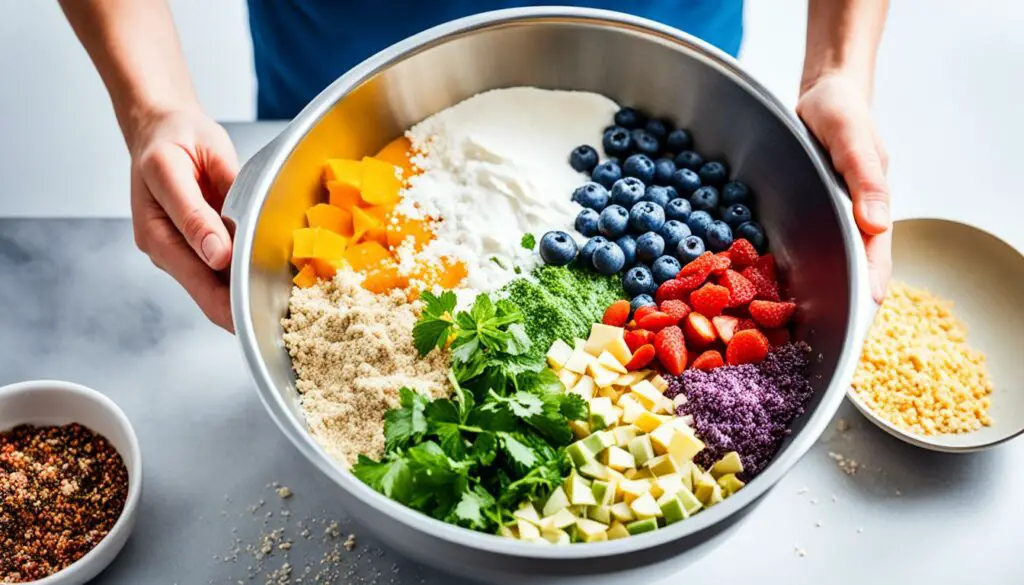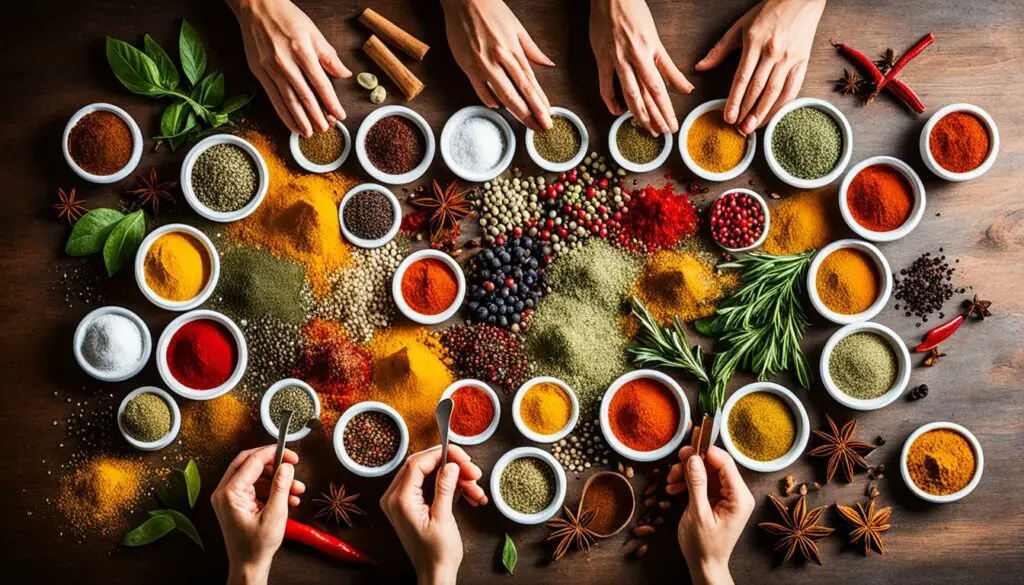Originally posted on April 2, 2024 @ 6:55 am
Did you know that over 80% of home cooks modify recipes to suit their taste preferences and dietary needs?
Adapting a recipe is a common practice, allowing individuals to customize their meals and add a personal touch to the dishes they prepare. Whether it’s changing the ingredients, adjusting cooking methods, or tweaking flavors, recipe modification offers endless possibilities in the kitchen.
In this article, we will explore the legal and ethical considerations of modifying recipes, provide tips on how to adapt a recipe properly, and offer practical advice for customizing your favorite dishes. So let’s dive in and discover the art of recipe adaptation!
Table of Contents
Key Takeaways:
- Adapting recipes is a popular practice among home cooks.
- Modifying a recipe allows for personalization and customization.
- Recipe adaptation should be done responsibly, respecting copyright and giving proper attribution.
- Consider practical factors such as pantry staples and budget when modifying recipes.
- Experimenting with ingredients, flavors, and cooking methods can lead to unique and delicious dishes.
Is Copying a Recipe Legal?
When it comes to copying a recipe, the question of legality arises. Are you allowed to copy someone else’s recipe and claim it as your own? Let’s delve into the world of copyright protection and plagiarism to understand the boundaries.
Firstly, it’s important to note that mere lists of ingredients are not subject to copyright protection. However, the situation becomes different when a recipe is accompanied by substantial literary expression or detailed directions. In such cases, there may be a basis for copyright protection.
Copying sentences, phrases, or specific wording without permission is considered plagiarism and can lead to legal consequences. It’s imperative to familiarize yourself with copyright laws to ensure you are on the right side of the law.
“Copying a recipe without permission is akin to taking someone else’s work and passing it off as your own. It’s essential to respect the creativity and effort put into developing a recipe by giving credit where it’s due.”
To protect yourself from copyright infringement and claims of plagiarism, it’s best to avoid copying recipes word-for-word. Instead, use them as a source of inspiration and adapt them to make them your own. By adding your unique touch, modifying cooking instructions, and tweaking ingredient quantities, you can create a recipe that reflects your creativity and personal flair.
Next, we’ll explore how to properly adapt a recipe while giving credit where it’s due. Stay tuned!
Summary:
- Mere lists of ingredients are not copyright protected, but recipes with substantial literary expression may be.
- Copying sentences, phrases, or specific wording without permission is considered plagiarism.
- Understanding copyright laws and avoiding word-for-word copying is essential.
- Adapting recipes and adding your personal touch is recommended to make them unique.
How to Adapt a Recipe Properly

When it comes to adapting a recipe, giving proper attribution is key. Whether you’re modifying ingredients or adjusting cooking methods, acknowledging the source of inspiration is essential to respect copyright and ethical guidelines. Here are some guidelines on how to adapt a recipe properly:
1. Adapted from and Inspired by
If you’re making minor modifications to a recipe that still closely resembles the original, it’s important to provide proper attribution. In this case, you can label your adapted recipe as “Adapted from” and include a link to the original source. By doing so, you give credit to the original creator and honor their work.
On the other hand, if you’ve made significant changes to the recipe, it’s appropriate to label it as “Inspired by.” This allows you to showcase your creativity while still acknowledging the original source that sparked your culinary experimentation. Just make sure to provide proper recipe attribution.
2. Recipe Attribution
When providing recipe attribution, it’s important to give credit where credit is due. If you found the recipe in a cookbook or on a website, mention the author’s name or website name, and provide a link to the original source. This way, others can explore the original recipe and further appreciate the culinary inspiration.
By giving proper recipe attribution, you not only show respect for the original creator but also contribute to a culture of honesty and transparency within the culinary community.
3. Modify Ingredients and Cooking Methods
Adapting a recipe often involves modifying ingredients and cooking methods. It’s important to make these changes while still maintaining the essence of the dish. Adjusting flavors, textures, and cooking times can help you create a recipe that suits your personal taste and dietary preferences.
For example, if you’re looking to make a recipe more wholesome, you can swap processed ingredients for whole foods or reduce the amount of saturated fat. Adding more vegetables or substituting ingredients to accommodate dietary restrictions can also enhance the nutritional value of the dish.
4. Experiment and Add Your Personal Touch
Adapting a recipe allows you to add your personal touch and experiment with different flavors and ingredients. Don’t be afraid to get creative and try new combinations. You can add herbs, spices, or other seasonings to elevate the taste profile of the dish.
Additionally, consider garnishing your adapted recipe with nuts, fresh herbs, or other visual elements to enhance its presentation. These small details can make a big difference in the overall appeal of the dish.
Remember, adapting a recipe is all about making it your own while respecting the original source. By giving proper attribution and adding your personal touch, you can create delicious dishes that reflect your culinary style and preferences.
Now, let’s take a look at a table that summarizes the key points of adapting a recipe:
| Key Points | Description |
|---|---|
| Adapted from | Minor modifications that still resemble the original recipe |
| Inspired by | Significant changes that showcase creativity |
| Recipe Attribution | Credit the original creator and provide a link to the source |
| Modify Ingredients | Swap or adjust ingredients to suit personal preferences or dietary needs |
| Cooking Methods | Adapt cooking methods to achieve desired results |
| Add Personal Touch | Experiment with flavors, spices, and garnishes to make the recipe your own |
Remember, adapting a recipe is all about customization and personalization while respecting the original source. With these guidelines and your culinary creativity, you can confidently adapt recipes to suit your taste and dietary needs.
Modifying Recipes for Health Benefits
When it comes to cooking and eating, making small changes can have a big impact on our health. Modifying recipes allows us to customize our meals to meet our nutritional needs and personal preferences. By incorporating more vegetables, reducing saturated fat, and being mindful of added sugars and salt, we can create healthier and delicious dishes. Here are some tips on how to modify recipes for health benefits:
Add More Vegetables
One of the easiest ways to make a recipe healthier is by adding **more vegetables**. Vegetables are packed with essential vitamins, minerals, and dietary fiber that promote good health. Consider including a variety of colorful vegetables like leafy greens, bell peppers, carrots, and broccoli in your recipes. They not only add nutrition but also contribute to the overall taste and texture of the dish.
Reduce Saturated Fat
Saturated fats, found primarily in animal products and processed foods, can increase the risk of heart disease when consumed in excess. To make your recipes healthier, **reduce saturated fat** by choosing leaner cuts of meat, trimming visible fat, and opting for cooking methods like grilling, baking, or steaming instead of frying. Additionally, you can replace high-fat ingredients, such as butter or heavy cream, with healthier alternatives like olive oil or Greek yogurt.
Mindful of Added Sugars and Salt
While sugar and salt add flavor to our dishes, excessive consumption can negatively impact our health. To modify recipes for health benefits, **be mindful of added sugars and salt**, and gradually reduce their amounts to adapt taste preferences. You can experiment with natural sweeteners like honey or maple syrup instead of refined sugar and use herbs, spices, or vinegar to enhance flavors instead of relying on excessive salt.
“Modifying recipes for health benefits does not mean sacrificing taste. It’s about making smart choices by incorporating more vegetables, reducing saturated fat, and being mindful of added sugars and salt.”
By modifying recipes, we have the power to transform our favorite meals into healthier versions without compromising on taste. Remember, small changes can bring significant health benefits in the long run. So, start experimenting in your kitchen and enjoy nutritious and delicious meals that nourish your body and delight your taste buds.
Swapping Ingredients and Measurements

When it comes to customizing a recipe, one of the easiest and most effective ways is to swap ingredients or adjust the measurements. By doing so, you can tailor the dish to your taste preferences, dietary needs, or ingredient availability. Let’s explore how you can make these substitutions and modifications while maintaining the balance of flavors and textures in your favorite recipes.
Substitute Ingredients
Substituting ingredients can be a great way to add variety and accommodate dietary restrictions. For example, if you’re looking to reduce your meat consumption, you can replace meat or chicken with legumes, such as lentils or chickpeas. These plant-based alternatives not only provide a good source of protein but also add a unique texture and flavor to the dish. Additionally, for those seeking healthier options, you can replace refined ingredients, like white flour or rice, with whole-grain alternatives, such as whole wheat flour or brown rice. These swaps offer more fiber, vitamins, and minerals, contributing to a nutritious meal.
Adjust Recipe Measurements
Recipe measurements play a crucial role in achieving the desired outcome. However, sometimes you may need to adjust them to suit your needs. If you want to make a smaller or larger batch, you can easily scale the measurements accordingly. For example, if a recipe calls for 1 cup of flour, you can halve it to 1/2 cup for a smaller portion or double it to 2 cups for a larger gathering.
When adjusting recipe measurements, it’s important to keep in mind that certain ingredients may require more precise modifications. Baking, for instance, relies heavily on accurate measurements to ensure proper texture and rising. It’s advisable to consult baking-specific resources or guidelines when modifying baking recipes.
Remember, adjusting recipe measurements may involve a bit of experimentation. Start with small modifications and taste as you go to make sure the flavors are balanced. It’s all about finding the right ratios to achieve the desired taste and consistency.
An Example of Ingredient Substitutions and Measurement Adjustments:
| Original Recipe | Modified Recipe |
|---|---|
| 1 lb chicken breast | 1 cup cooked lentils |
| 2 cups all-purpose flour | 1 cup whole wheat flour |
| 1/2 teaspoon salt | 1/4 teaspoon salt |
| 1 teaspoon vanilla extract | 1/2 teaspoon vanilla extract |
Note: Table showcasing an example of ingredient substitutions and measurement adjustments in a recipe.
By swapping ingredients and adjusting measurements, you can make your recipes truly your own. It allows for flexibility in your culinary creations while still maintaining the essence and structure of the dish. Don’t be afraid to experiment and explore different substitutions to discover new flavors and combinations that suit your taste buds. Whether you’re catering to specific dietary needs, exploring healthier options, or simply adding a personal touch, swapping ingredients and adjusting measurements can transform a recipe into something uniquely yours.
Image illustrating ingredient substitutions and recipe measurement adjustments.
Changing Cooking Methods
When it comes to preparing meals, altering the cooking method can bring a whole new dimension to your dishes. Whether you’re looking to **alter dish preparation steps** or **change the cooking method** to cater to personal preferences or dietary needs, there are various options to explore. Roasting, grilling, or steaming can be fantastic alternatives to traditional methods like frying or sautéing, adding depth of flavor and texture to your recipes.
Adjusting the cooking time and temperature may also be necessary when using a different cooking method. For example, roasting vegetables at a slightly higher temperature can result in a crispy exterior and a tender interior. Steaming delicate seafood can help retain its natural moisture and tenderness.
Experimenting with different cooking methods not only enhances the taste and texture of your dishes but also opens up a world of culinary possibilities. By embracing versatility in the kitchen, you can create meals that cater to your unique preferences while still delivering on flavor and nutrition.
Roasting vs. Sautéing: A Comparison
| Method | Roasting | Sautéing |
|---|---|---|
| Definition | Slow cooking method using dry heat in an oven or open flame | Quick cooking method using a small amount of oil or butter over high heat |
| Advantages |
|
|
| Disadvantages |
|
|
| Example Dish | Roasted chicken with root vegetables | Sautéed shrimp with garlic and lemon |
Understanding the impact of the cooking method on the final dish is crucial to achieving the desired outcome. It’s important to experiment, make adjustments, and discover the cooking methods that complement your ingredients and bring out their best qualities. Remember, cooking is a creative journey, so don’t be afraid to explore and try new techniques!
Tips for Adding Flavor and Variety

When it comes to making a recipe truly your own, there are endless possibilities to explore. By tweaking the recipe, customizing the taste, and enhancing flavors, you can create a culinary masterpiece that is uniquely yours. Here are some tips to help you infuse your dishes with extra flavor and variety:
Experiment with Different Spices, Herbs, and Seasonings
Spices, herbs, and seasonings are the secret ingredients that can take a dish from ordinary to extraordinary. Don’t be afraid to venture beyond the usual suspects and explore new flavors. Try adding a dash of cumin for an earthy warmth, a sprinkle of paprika for a smoky kick, or a pinch of cinnamon for a touch of sweetness. Experiment with different combinations to create your own signature flavor profile.
Add Garnishes for Visual Appeal
Enhancing the visual appeal of a dish can make it even more enticing. Consider adding garnishes like chopped nuts or fresh herbs to your creations. These simple additions not only add a pop of color and texture but also elevate the overall presentation. A sprinkle of chopped parsley, a handful of toasted almonds, or a drizzle of balsamic reduction can make your dish look as good as it tastes.
Seek Inspiration from Different Cuisines
One of the best ways to enhance the flavors in your dishes is to draw inspiration from different cuisines. Explore the vibrant spices of Indian cuisine, the zesty flavors of Mexican cuisine, or the delicate herbs of Italian cuisine. By incorporating elements from diverse culinary traditions, you can create fusion dishes that are rich in both flavor and cultural influences.
“Customizing the taste of a recipe is all about letting your creativity take the reins. Don’t be afraid to experiment and trust your palate.” – Spice enthusiasts
Balance Flavors and Textures
When adding flavors to a recipe, it’s crucial to maintain a balance between the various taste profiles. Aim for a harmonious combination of sweet, savory, salty, and tangy elements. Additionally, consider the texture of the dish. Pair creamy ingredients with crunchy toppings or incorporate contrasting textures in each bite for a more delightful dining experience.
| Flavorful Ingredient | Complementary Dishes |
|---|---|
| Fresh Basil | Caprese Salad, Margherita Pizza |
| Garam Masala | Butter Chicken, Vegetable Biryani |
| Lime Juice | Ceviche, Thai Papaya Salad |
| Soy Sauce | Stir-Fried Noodles, Teriyaki Salmon |
Don’t Be Afraid to Tweak and Adjust
Remember, a recipe is merely a suggestion. Feel free to tweak and adjust it to suit your taste preferences. If a recipe calls for a teaspoon of chili powder but you prefer a milder heat, reduce the amount or swap it for a different spice altogether. Similarly, if you want to enhance the umami flavors in a dish, add a splash of soy sauce or a sprinkle of nutritional yeast. Let your taste buds be your guide.
Adding flavor and variety to your recipes is a delightful journey of culinary exploration. By customizing tastes, tweaking recipes, and enhancing flavors, you can create dishes that are uniquely yours. Have fun in the kitchen, experiment with different ingredients and techniques, and let your creativity shine through each and every meal.
Practical Considerations for Recipe Modification

When it comes to modifying recipes, there are practical factors to consider that can help make the process easier and more enjoyable. From pantry staples to budget and ingredient availability, these considerations can play a crucial role in successful recipe adaptation.
Stock Your Pantry
One practical tip for recipe modification is to keep a well-stocked pantry with basic ingredients. Having essential items on hand, such as herbs, spices, oils, and canned goods, can make it easier to modify recipes on the go. It allows for greater flexibility in experimenting with flavors and substituting ingredients.
Plan Your Meals
Meal planning is another practical approach that can support your recipe modification journey. By planning your meals ahead of time, you can ensure a balanced and varied diet. Take into account your dietary goals, preferences, and available ingredients when planning your meals for the week. This way, you can make the necessary adjustments to recipes and ensure you have all the necessary items on hand.
Be Flexible and Creative
Flexibility and creativity are key when it comes to adapting and customizing recipes. Don’t be afraid to experiment with different ingredient combinations or cooking techniques. Embrace the opportunity to try new flavors and textures while keeping in mind your dietary needs and preferences.
Remember, there’s no right or wrong way to modify a recipe. It’s a personal journey of culinary exploration and self-expression.
Avoid Clustering, Distribute Information Evenly
For more information on meal planning and practical tips for recipe modification, check out this resource.
By taking these practical considerations into account, you can confidently embark on your recipe modification adventures while creating delicious and personalized meals.
| Practical Tips for Recipe Modification | Meal Planning | Flexibility and Creativity |
|---|---|---|
| Stock your pantry with essential ingredients | Plan meals ahead of time | Experiment with ingredient combinations |
| Keep herbs, spices, oils, and canned goods on hand | Consider dietary goals and preferences | Embrace new flavors and textures |
| Substitute ingredients based on availability | Ensure a balanced and varied diet | Adjust cooking techniques as needed |
Conclusion
Adapting recipes is a common practice for home cooks everywhere. However, it is crucial to approach recipe modification responsibly and ethically. Understanding copyright laws and giving proper attribution to original sources is essential. By doing so, you not only respect the hard work of recipe creators but also ensure a fair and legal use of their content.
Modifying recipes offers a wonderful opportunity for personalization and customization, allowing you to tailor meals to your own preferences and dietary needs. Whether it’s adding more vegetables, reducing saturated fat, or changing cooking methods, you have the freedom to create dishes that are uniquely yours.
With a sprinkle of creativity and a dash of willingness to experiment, anyone can embark on a culinary journey of discovery by adapting and customizing recipes. Remember, cooking is an art, and just like any art form, it thrives on individual expression and interpretation.
So, the next time you find yourself asking, “Can you change the recipe?” the answer is a resounding yes! Unlock your imagination, embrace the joy of cooking, and let your taste buds guide you on a delicious adventure.
For more information and helpful tips on modifying recipes, check out this resource from South Dakota State University Extension.
FAQ
Can you change the recipe?
Yes, recipes can be changed and customized to suit personal preferences.
Is copying a recipe legal?
Copying a recipe verbatim without giving credit is not allowed. Familiarize yourself with copyright laws and avoid plagiarism.
How to adapt a recipe properly?
When adapting a recipe, give proper attribution. If the recipe is modified but still resembles the original, call it “Adapted from.” If the changes are significant, call it “Inspired by.”
Can recipes be modified for health benefits?
Yes, recipes can be modified by adding more fruits and vegetables, reducing saturated fat, and incorporating high-fiber ingredients.
Can ingredients and measurements be swapped?
Yes, ingredients can be substituted and recipe measurements can be adjusted to suit personal preferences and dietary needs.
Can cooking methods be changed?
Yes, the cooking method can be altered to suit personal preferences or dietary needs. Roasting, grilling, and steaming are alternatives to frying or sautéing.
How to add flavor and variety to a recipe?
Personalize a recipe by experimenting with different spices, herbs, and seasonings. Adding garnishes like nuts or fresh herbs can enhance the visual appeal.
What practical considerations should be kept in mind when modifying a recipe?
Consider pantry staples, budget, and ingredient availability. Meal planning can help ensure a balanced and varied diet.
Can you change the recipe?
Yes, recipes can be changed and customized to suit personal preferences. With creativity and a willingness to experiment, anyone can adapt recipes to their needs.
Source Links
- https://www.davidlebovitz.com/recipe-attribution/
- https://diannej.com/2010/adjusting-a-recipe-doesnt-make-it-yours/
- https://www.eatforhealth.gov.au/eating-well/healthy-recipes/recipe-modification-tips
See also:
Leave a Reply